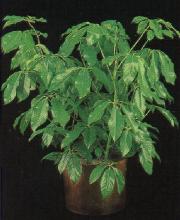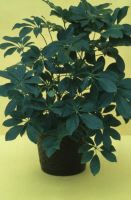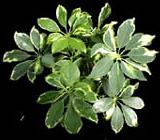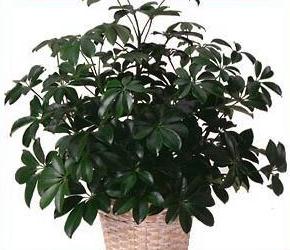|
Plants
for your home
(By Mary Efanti)
Schefflera
Origin - Description
 Schefflera is a tropical
plant, native to Malaysia and is popular in two varieties, Actinophylla and Arboricola
(Umbrella-tree). This care-guide focuses on the Arboricola variety, referred to as Schefflera in the rest of this
text. Schefflera is very popular plant in Greece, mainly as a houseplant but used in our balconies as
well. Its oval-shaped leaves are green and fleshy, and it develops in a tree-like
form, reaching impressive growth after a few years. A stem originating from the main branch is carrying 4-5 leaves spread in a roundish
shape, much like the fingers of our hands. There is also a variegated
schefflera, that has darker green leaves with yellow blotches. Schefflera is a tropical
plant, native to Malaysia and is popular in two varieties, Actinophylla and Arboricola
(Umbrella-tree). This care-guide focuses on the Arboricola variety, referred to as Schefflera in the rest of this
text. Schefflera is very popular plant in Greece, mainly as a houseplant but used in our balconies as
well. Its oval-shaped leaves are green and fleshy, and it develops in a tree-like
form, reaching impressive growth after a few years. A stem originating from the main branch is carrying 4-5 leaves spread in a roundish
shape, much like the fingers of our hands. There is also a variegated
schefflera, that has darker green leaves with yellow blotches.
Care
Schefflera needs plenty of light to grow, but not direct
sunlight. During summer make sure that no direct sunlight reaches the plant, especially through windows that make sun rays even more
dangerous, or in the balcony because her leaves will get sunburned.
Schefflera tolerates well high
temperatures, so water only when the top-soil is dry in order to prevent root
rot. For the same reason, empty the excess water from the plate below the pot. This will also help get rid of the annoying little flies
(gnats) who live in damp plates and fly around in your home.
Even though it is draught tolerant, schefflera needs moisture in the environment where it
lives. So take care to provide the moisture necessary. If your plant is on the
balcony, mist its leaves as often as you can, but during summer do not allow direct sunlight on the wet
leaves, as they will get sun-burned.
 If the plant is inside your house, misting is not enough. Especially in winter, when heating dries out the
air, increase moisture by placing metal containers with water on the radiators. As the water
evaporates, the leaves can absorb the moisture. This can help but the best solution is to place plants in
groups, on a tray filled with wet pebbles. As water evaporates from the tray, the leaves will absorb the
moisture. Be careful that pots do not sit on water but on the pebbles, to prevent root
rot. Moisture in the atmosphere is as beneficial to people as much as to the
plants.
If the plant is inside your house, misting is not enough. Especially in winter, when heating dries out the
air, increase moisture by placing metal containers with water on the radiators. As the water
evaporates, the leaves can absorb the moisture. This can help but the best solution is to place plants in
groups, on a tray filled with wet pebbles. As water evaporates from the tray, the leaves will absorb the
moisture. Be careful that pots do not sit on water but on the pebbles, to prevent root
rot. Moisture in the atmosphere is as beneficial to people as much as to the
plants.
 Inside your home, clean its leaves with a soft cloth, damp with lukewarm water, as often as possible in order to remove the dust from the leaves and allow
photosynthesis. If you have some spare time offer your plant a gift: Place it in your bathtub and give it a delicate but thorough lukewarm
shower, let it dry in the bathroom so it can absorb moisture before you return it to its original
position.
Inside your home, clean its leaves with a soft cloth, damp with lukewarm water, as often as possible in order to remove the dust from the leaves and allow
photosynthesis. If you have some spare time offer your plant a gift: Place it in your bathtub and give it a delicate but thorough lukewarm
shower, let it dry in the bathroom so it can absorb moisture before you return it to its original
position.
 Scheffleras do well in the same pot for a long
time, if you make sure that the soil is rich in nutrients, by feeding and adding new soil on
top. You will need to repot when the roots show up on the surface and try to use a pot that is only 1-2 sizes bigger so that the root system does not develop more than
foliage. Scheffleras do well in the same pot for a long
time, if you make sure that the soil is rich in nutrients, by feeding and adding new soil on
top. You will need to repot when the roots show up on the surface and try to use a pot that is only 1-2 sizes bigger so that the root system does not develop more than
foliage.
Remove yellowing leaves so that the plant does not waste energy for them and turn the pot by a quarter each time you water so that the plant does not get
leggy, reaching for the sun.
If you want a bushier plant, you can pinch back top growth so that the plant channels its energy to the development of the lower
branches. Also, remove the new growth/suckers that appears next to the main branch in the
soil, so that the main plant can develop. In spring, you will notice new leaves shooting out of the main
branches. It is advisable that you tie these new branches when still young and tender in order to control the shape of the plant as it
grows.
Fertilizing
Use a fertilizer for foliage plants, always according to the instructions on the packaging and 2-3 times a year add some liquid iron to avoid yellowing of the
leaves.
Disease - Pests
Scheffleras are prone
to scale and aphids. You will identify them if you notice on the
underside of the leaves or on the branches, tiny flat spots in dark
brown, green, white or even grey colour. These spots look so natural on
the plant that you might think they are part of the plant itself. There
are two ways to make sure: try to remove the spots with your nail or
with the round end of a knife; if you can remove the spot you can be
certain that it is not part of the plant but a sign of disease.
Also, for both diseases,
check the leaves for honeydew, a sticky substance that these insects
produce. These diseases can be managed effectively if noticed early but
take immediate measures as they spread quickly to neighboring plants. If
untreated, they can destroy the affected plant.
To get rid of scale, do
the following:
1. Isolate the affected
plant and check neighboring plants thoroughly for symptoms. Especially
if you have Benjamin ficus or poinsetia close to the affected plant,
check them very carefully as they are prone to scale insects.
2. Take a close look at
the plant and remove those leaves that are severely affected. Use a
plastic bag to discard of the affected leaves, do not place them in open
trash bins inside your home because the disease might spread to other
houseplants.
 3. Cover the pot with a
plastic bag, place the pot in your bathtub and give it a long, intense
shower, with lukewarm water. The shower should last for some time so
that the leaves will get cleaned well. After turning off the water, let
the plant in your bathroom in order to absorb the moisture of the room.
A good shower and a room with plenty of moisture is the best gift you
can offer to green tropical plants, such as schefflera and benjamin, and
not only when they are “sick”. 3. Cover the pot with a
plastic bag, place the pot in your bathtub and give it a long, intense
shower, with lukewarm water. The shower should last for some time so
that the leaves will get cleaned well. After turning off the water, let
the plant in your bathroom in order to absorb the moisture of the room.
A good shower and a room with plenty of moisture is the best gift you
can offer to green tropical plants, such as schefflera and benjamin, and
not only when they are “sick”.
4. While the plant
dries prepare the “practical recipe” for a scale insecticide. Mix
lukewarm water with rubbing (blue) alcohol (3 parts water with 1 part
alcohol) and add 2-3 drops of ordinary dishwashing liquid. Mix well and
spray the plant, making sure that new growth and the underside of the
leaves are thoroughly soaked. Repeat spraying 7-10 days later. If scale
insists, repeat spraying 10 days later. Of course, you can always visit
a nursery and ask for the suitable insecticide. Scale insects are quite
persistent and often return, so check your plants for symptoms often.
Aphids are tiny black
and green flies that attack new growth or the underside of leaves and
suck the plant’s juices. To get rid of aphids, isolate the affected
plant so that the disease does not spread, and spray the plant with the
same mix described above or with common household insecticide. If you
choose to use the insecticide method, apply that only to plants on your
balcony and not inside your home, and be prepared to see the new growth
you sprayed wither and fall.
Scheffleras are long-living
plants and grow fast, if you provide for their needs they will keep you
company for a long-long time.
Mary Efanti
[email protected]
|
